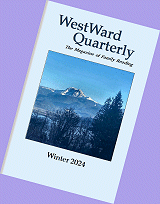Building Your Author Web Site
Many writers like to share their work or advertise their publications via a web site. To have a web site, of course, requires that you be able to use a computer and have a connection to the Internet, preferably a high-speed connection such as DSL (Digital Subscriber Line), available through your phone company or another provider. Along with this, of course, comes the need for an email address which — if you don’t already have one — is usually included with your Internet connection.
Building your web site file “from scratch” requires knowledge of HTML (Hypertext Markup Language) and CSS (Cascading Style Sheet) source code. These are the codes that tell the browser (“user agent”), such as Internet Explorer or Firefox, how to display your page on the user’s screen. Our WestWard Quarterly site (wwquarterly.com) and my author site (rcleonard.com) are built that way, but if you’re a beginner to web sites you won’t want to get that technical. There are alternatives.
Many services offer an easy way to put your author site on the Internet. They provide web site building software, with which you design your page without having to understand the source code, plus instructions on how to make changes (i.e., upload new material). A few that we found are webs.com and wix.com. Yahoo offers free web sites, and templates to build them; to check out what they have to offer go to smallbusiness.yahoo.com/webhosting.
Other providers charge upward from $3.50 per month. The advantage in using a paid site is usually better customer service, in case you encounter problems. Some of these providers are ipage.com, fatcow.com, inmotionhosting.com, startlogic.com and godaddy.com. We don’t have much experience with the free web site providers, but assume they’re easy to use. Our web sites are hosted on GoDaddy, but we write our own code and don’t use their web site builder. We use a separate program to upload files.
Some authors are starting their web sites as a “blog” (slang for “web log”). Blog providers offer the same services as the free web site providers described above, including standard templates you can modify to create a distinctive appearance. Blogs are popular because they let viewers comment on the material you post. Many writers use Blogger (blogger.com), part of Google’s operation, or WordPress (wordpress.com)). With a blog your web site address (URI, or "Uniform Resource Identifier") usually ends with the name of the blog host, and your blog name appears in a subdomain, such as ellenolinger.wordpress.com, for WordPress. If you want your own name, such as johnpetrolino.com, you need a standard site. (Both of these writers have contributed to WestWard Quarterly.) To have your distinctive site name, you need to obtain an available “domain name” from a registrar who can assign it. Many domain names end in ".com" or ".net," but other domain identifiers have recently become available.
My author blog, “Considered Opinion,” is considop.blogspot.com but it’s incorporated into my site, rcleonard.com, which required me to modify Blogger’s code. Beginners won’t want to try that until they know how to code straight HTML and CSS.
If you know a local “tech” type, perhaps he or she will help you get your web site up and running. We offer such a service through our hosting operation, R. C. Leonard (go to forecyte.com to see our work). Our charge for a personal or non-profit site is $19.95 per month. You just need to provide us with your materials (text and images) and we do the rest.
Happy Web-Siting!
The Publisher
©2011 Laudemont Press


